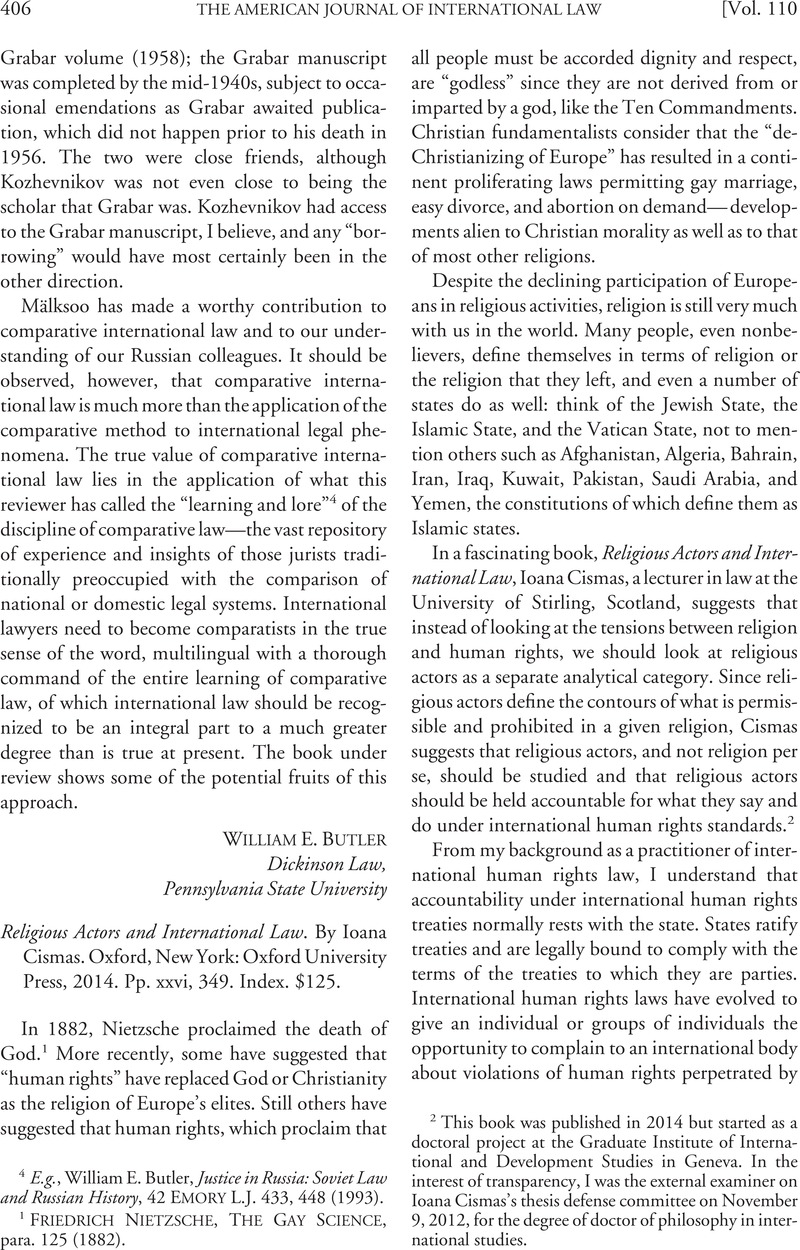No CrossRef data available.
Published online by Cambridge University Press: 20 January 2017

1 Friedrich Nietzsche, The Gay Science, para. 125 (1882).
2 This book was published in 2014 but started as a doctoral project at the Graduate Institute of International and Development Studies in Geneva. In the interest of transparency, I was the external examiner on Ioana Cismas’s thesis defense committee on November 9, 2012, for the degree of doctor of philosophy in international studies.
3 International Covenant on Civil and Political Rights, Art. 2, Dec. 16, 1966, 999 UNTS 171 (entered into force Mar. 23, 1976).
4 American Convention on Human Rights, Art. 1, Nov. 22, 1969, 1144 UNTS 123, 9 ILM 673 (1970) (entered into force July 18, 1978).
5 Velásquez Rodríguez v. Honduras, Inter-Am. Ct. H.R. (ser. C) No. 4, para. 172 ( July 29, 1988), 28 ILM 291 (1989) (case involving disappearance of Manfredo Velásquez, a student, allegedly by the government of Honduras).
6 Id. (emphasis added).
7 Id., para. 79.
8 Id.
9 Id., para. 174.
10 Id., para. 175.
11 UN Human Rights Comm., Herrera Rubio v. Colombia, Comm. No. 161/1983, para. 10.3 (Nov. 2, 1987), UN GAOR, 43d Sess., SuPp. No. 40, UN Doc. A/43/40, at 197 (1990).
12 Id., para. 11 (emphasis added).
13 UN Human Rights Comm., General Comment 20, Art. 7, UN Doc. A/47/40, Annex VI, at 195, para. 13 (1992) (emphasis added).
14 Alistair Mowbray, The Development of Positive Obligations Under the European Convention on Human Rights by the European Court of Human Rights (2004).
15 Id. at 2 (footnotes omitted).
16 Andrew Clapham, Human Rights in the Private Sphere (1993); Andrew Clapham, Human Rights Obligations of Non-State Actors (2006).
17 Rodolfo Luis Correa Belisle, Friendly Settlement, Report No. 15/10, 2010 Rep. Inter-Am. Comm. H.R. (Mar. 16, 2010), available at http://www.cidh.oas.org/annualrep/2010eng/ARSA11758EN.doc; Argüelles v. Argentina, Preliminary Objections, Merits, Reparations & Costs, Inter-Am. Ct. H.R. (ser. C) No. 288 (Nov. 20, 2014), available at http://www.corteidh.or.cr/docs/casos/articulos/seriec_288_esp.pdf.
18 Almonacid-Arellano v. Chile, Preliminary Objections, Merits, Reparations & Costs, Inter-Am. Ct. H.R. (ser. C) No. 154, para. 131 (Sept. 26, 2006), available at http://www.corteidh.or.cr/docs/casos/articulos/seriec_154_ing.pdf.
19 For example, in Manoussakis v. Greece, 1996-IV Eur. Ct. H.R. 1364, the applicants, Jehovah’s Witnesses, were prosecuted and convicted for operating a place of worship without the specific authorization required by law. The ECtHR affirmed that the right to religious freedom “excludes any discretion on the part of the State to determine whether religious beliefs or the means used to express such beliefs are legitimate.” Id., paras. 44, 47. The ECtHR declared that there had been a violation of the right to religious freedom and that national legislation had been utilized “to impose rigid, or indeed prohibitive, conditions on practice of religious beliefs by certain non-Orthodox movements, in particular Jehovah’s Witnesses.” Id., para. 48.
20 Citing Schüth v. Germany, App. No. 1620/03, 2010-V Eur. Ct. H.R. 397, available at http://www.echr.coe.int/Documents/Reports_Recueil_2010-V.pdf.
21 International Convention on the Elimination of All Forms of Racial Discrimination, Dec. 21, 1965, S. Exec. DOC. 95-C (1978), 660 UNTS 195.
22 Convention Against Torture and Other Cruel, Inhuman or Degrading Treatment or Punishment, Dec. 10, 1984, S. Treaty Doc. No. 100-20 (1988), 1465 UNTS 113.
23 Convention on the Rights of the Child, Nov. 20, 1989, 1577 UNTS 3.
24 Optional Protocols to the Convention on the Rights of the Child on the Involvement of Children in Armed Conflict and on the Sale of Children, Child Prostitution and Child Pornography, GA Res. 54/263 (May 25, 2000), S. Treaty Doc. No. 106-37 (2000).
26 Committee on the Rights of the Child, Concluding Observations on the Second Periodic Report of the Holy See, para. 8, UN Doc. CRC/C/VAT/CO/2 (Feb. 25, 2014).
27 Id.
28 Comments of the Holy See on the Concluding Observations Of the Committee on the Rights of the Child, para. 3 (Feb. 5, 2014), available at http://www.vatican.va/roman_curia/secretariat_state/2014/documents/rc-seg-st-20140205_concluding-observations-rights-child_en. html.
29 The Organization for Security and Co-operation in Europe (OSCE) also has a membership of fifty-seven countries spread over three continents.
30 See also Commission on Human Rights, Res. No. 1999/82, Defamation of Religions, para. 3, UN Doc. E/CN.4/1999/167 (Apr. 30, 1999).
31 UN Human Rights Council Res. 16/18, Combating Intolerance, Negative Stereotyping and Stigmatization of, and Discrimination, Incitement to Violence and Violence Against, Persons Based on Religion or Belief, para. 5(h), UN A/HRC/RES/16/18 (Apr. 12, 2011).
32 Pew Research Center, Laws Penalizing Blasphemy, Apostasy and Defamation ofReligion Are Wide spread (Nov. 21, 2012), at http://www.pewforum.org/2012/11/21/laws-penalizing-blasphemy-apostasy-and-defamation-of-religion-are-widespread.
33 Hanibal Goitom, Global Legal Research Center, Laws Criminalizing Apostasy (Law Library of Congress, May 2014), available at http://www.loc.gov/law/help/apostasy/apostasy.pdf.
34 Cairo Declaration on Human Rights in Islam, Aug. 5, 1990, UN Doc. A/CONF.157/PC/62/Add.18(June 9, 1993).
35 Covenant on the Rights of the Child in Islam, OIC/9-IGGE/HRI/2004/Rep.Final (2005), available at http://www.cfr.org/children/covenant-rights-child-islam/p26366 (not yet entered into force).
36 Statute of the OIC Independent Permanent Human Rights Commission, OIC/IPCHR/2010/STATUTE (2011), 50 ILM 1148 (2011), available at http://www.oic-iphrc.org/en/data/docs/about/Statute/IPHRC%20Statute%20EV.pdf.
37 Despite Article 3(2) of the OIC Charter, which specifies that “[a]ny State, member of the United Nations, having Muslim majority and abiding by the Charter” may apply for membership in the OIC, Suriname and Guyana have been accepted asmembers with only 13.5 percent and 12 percent Muslim populations, respectively. OIC Charter, Art. 3(2) (Mar. 14, 2008), available at http://www.oic-oci.org/is11/english/charter-en.pdf.